1949 - GYRODYNE enters the coaxial helicopter field.
By 1951, after 2 years of experiment and research, Gyrodyne is approached
by the Navy to demonstrate that the problems associated with the controversial
Coaxial helicopter design have been solved. 1 year later, the Flight Report
submitted to the Navy is accepted.
1954 - Gyrodyne is selected as one of the winners to provide ultra-light
one-man helicopters to the U.S. Marine Corps.
1955 - First flight of what Gyrodyne calls "The Rotorcycle" occurs on
November 23, 1955.
1956 to 1959 - As part of the Marine Corps. contract, Gyrodyne model XRON-1
accumulates 1200 flight hours (see above photo of
USMC Marine Corps-Gyrodyne team; Gyrodyne President, Peter J. Papadakos is top row, far
left)
April 1958 - The Department of the Navy authorizes Gyrodyne to make minimum
modifications to an existing Rotorcycle to make it completely controllable
from the ground by means of an off-the-shelf (OTS) avionics equipment in order
to investigate its feasibility as a drone.
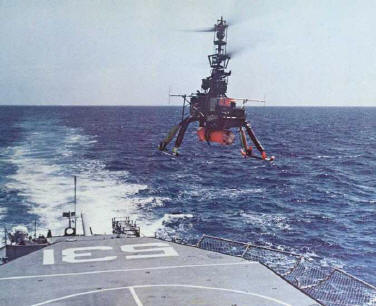 December
31, 1958 - Navy issues a contract to Gyrodyne to develop the DSN-1 (later
designated QH-50A) Drone, based on the feasibility study.
December
31, 1958 - Navy issues a contract to Gyrodyne to develop the DSN-1 (later
designated QH-50A) Drone, based on the feasibility study.
1959 to Summer 1960 - DSN-1 Development program and testing at Naval Air
Test Center, Patuxent River, Maryland begins. By Summer of 1960, the
Safety-Pilot accommodations are removed.
August 12, 1960, the first free-flight of an unmanned
helicopter in history occurs at Naval Air Test Center, Patuxent
River, Maryland.
September 30, 1960 - First flight of Twin Porsche-engine powered, DSN-2
(later classified QH-50B) occurs. With only 3 built, the DSN-2 is used to
effect a transition from the analog data link to the digital system planned
for the operational vehicle. The DSN-2 is flown only in the man-carrying or
piloted drone configuration.
December 7, 1960 - The First successful drone /
UAV
helicopter flight FROM SHIP at SEA is performed from the USS HAZELWOOD
(DD-531). During subsequent Contractor Operations Evaluations
Trials off Key West, Florida, 38 flights are made from HAZELWOOD with 22
simulated ASW Missions in 350 flight hours confirming the feasibility of the
DASH Weapon System.
January 1961 - Navy approves of creating DSN-3 (later classified QH-50C)
Drone by using available and proven Boeing T-50 Turbine Engine so heavy fuel
can be used vs. aviation-gasoline-fueled Porsche engine.
June 1961 - With Gyrodyne Test Pilot Jim Ryan at the controls, the
Optimized Rotorcycle (YRON) with a 72 HP Porsche Engine and 20' Rotor diameter
WINS Honors at the Paris Air Show for its performance and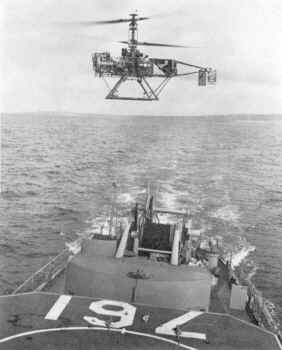 maneuverability.
maneuverability.
January 25, 1962 - First Flight of the pure drone QH-50C at NATC, Patuxent
River, Maryland occurs.
July 18, 1962 - Successful completion of Demonstration Program of QH-50C
Drone. By September 4, 1962 the successful completion of Initial Trials Phase
of Board of Inspection and Survey Trials had also been accomplished at NATC,
Patuxent River, Maryland.
November 15, 1962 - Initial production delivery of QH-50C drones commences.
January 7, 1963 - The USS Buck (DD 761)(seen right),
while operating off San Clemente Island, California, completed Ships
Qualification Trials and became the first United States warship to receive
operational drone helicopters, which were delivered by flying them from the
Island out to the ship. To watch a film clip of a typical QH-50 ASW mission,
CLICK HERE.
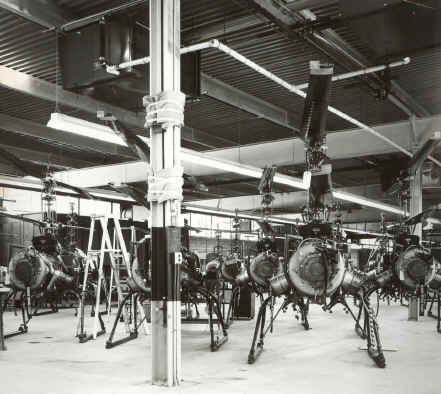 1961
to 1964 - Introduction to the U.S. Naval Fleet of the QH-50C Drone (seen
left). 373 Aircraft were delivered during this time with over 8,000 flight hours accumulated.
Aircraft flew with wooden rotor blades with low-level integrated circuit
digital avionics. Aircraft used the Boeing T50-BO-6/8A Turboshaft engine
yielding a military power of 300 BHP at 5950 RPM.
1961
to 1964 - Introduction to the U.S. Naval Fleet of the QH-50C Drone (seen
left). 373 Aircraft were delivered during this time with over 8,000 flight hours accumulated.
Aircraft flew with wooden rotor blades with low-level integrated circuit
digital avionics. Aircraft used the Boeing T50-BO-6/8A Turboshaft engine
yielding a military power of 300 BHP at 5950 RPM.
Nov. 1963 to 1971-
Gyrodyne deploys 1st group of Technical Representatives (TechReps) to
Yokosuka, Japan to support WESTPAC Navy DASH-equipped ships. Consisting of one
Boeing, one Babcock and 3 Gyrodyne reps, the DASH team are first assigned to
MOTU-7 and then to (Command Task Unit) CTU 70.8.1 be more proactive and
resolve issues with DASH before they became a problem. When SNOOPY Recon QH-50
missions begin to occur in 1966, the C.O., LCDR N. Jackson, USN makes SNOOPY a
priority to Yokosuka-based ships because of Techrep availability. By 1968,
Techreps number 10.
April 9, 1965 - First Flight of QH-50D Drone;
QH-50D incorporates all fixes and lessons learned from C-model, including
all-weather wiring with modular architecture for ASW-20 automatic flight
control system.
1965 to 1969 - Introduction to the U.S. Naval Fleet of the QH-50D Drone. 377
Aircraft delivered with a more modern Boeing T50-BO-12 engine, rated at 330 BHP.
Tail section removed from the earlier “C” model and the rotor blades changed
to an all fiber glass blade made at Gyrodyne. During this time over 12,000
flight hours are accumulated. To see a QH-50D fly a mission,
CLICK HERE.
1965 - Under contract from the Navy, Gyrodyne develops the LAD/SLAD system
for Landing Assist device for high sea states.
1966 to 1976 - Introduction to the Japanese Marine Self-Defense Force
(JMSDF) of the QH-50C/D. See right. The
U.S. Navy supplied the JMSDF 4 QH-50C/D aircraft. The
Nissho-Iwai Trading Company procured an additional 14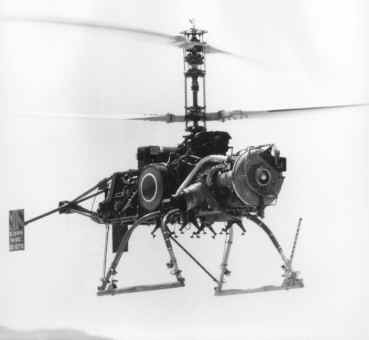 QH-50D drones for the JMSDF DASH program.
Deliveries commence in early 1967. While flying over 2000 flight hours
during this period, they achieve the lowest operational losses of any deployed
system; their mean time before losses (MTBL) was 500 hours.
QH-50D drones for the JMSDF DASH program.
Deliveries commence in early 1967. While flying over 2000 flight hours
during this period, they achieve the lowest operational losses of any deployed
system; their mean time before losses (MTBL) was 500 hours.
1966 - Under Navy Contract, Gyrodyne develops a Blade de-icing program.
4 QH-50s get the complete de-ice, all weather capability but that is all. All
future blades keep heater-mats but are not powered.
1966 - Under Navy Contract, Gyrodyne qualifies the Allison T63 Turbo shaft
engine for use on the QH-50, designated QH-50E.
1967 -1971 - With Gyrodyne assistance, the Navy flies QH-50C's and then
QH-50D’s from U.S. Naval Destroyers with real time video-capability over
Vietnam under Navy project "SNOOPY". This is the first time, real-time-aerial surveillance and Naval Gun
Fire Support Missions by a rotary wing drone / unmanned aerial vehicle (UAV)
is achieved from ships, in the Tonkin Gulf. QH-50s start getting shot
down over Vietnam on these missions and is reflected in the herein MTBL loss
rates. To see a SNOOPY RECON MISSION,
CLICK HERE.
September 25, 1967 - Responding to a request by the Commander, U.S.
Marine Corps-Vietnam for a "Quick reaction on DMZ Gun Problem", Naval Air
Development Center (NADC)-Johnsville
begins to modify 4-DASH QH-50 aircraft to use Low Light Level TV (LLLTV) for
standoff reconnaissance capability.
September 28, 1967 - U.S. Air Force starts project BLOW LOW with
ARPA monitoring and providing technical assistance on this
quick-reaction-effort. Equipped with remote sensors, the QH-50 BLOW LOW would have a
weapon-system-capable of attacking gun positions within the DMZ in Vietnam.
BLOW LOW later evolves into a missile-attack-system for attack-on-ground
targets called LARS (Laser Aided Rocket System).
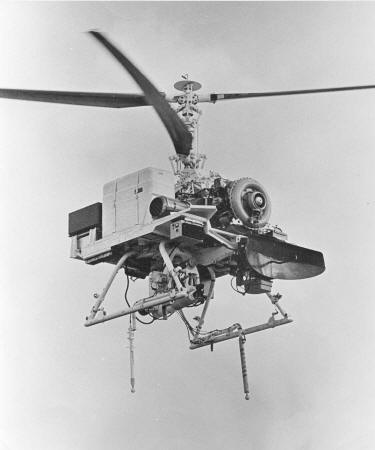 January
1968 - NITE GAZELLE Program is started by ARPA and is an offshoot of
BLOW LOW; The concept of operation is to
hunt and kill high priority targets in Vietnam using NAVY QH-50 DASH
helicopters equipped with accurate sensing systems and weapon delivery
capability. NAVAIR acts as agent on behalf of the bailed-Navy QH-50s. U.S.
ARMY Missile Command (MICOM) supports and monitors under
Contract No. DAAH01-72-0982. Col. George H. Greenleaf acts as ARPA TTO
technical monitor. Gross
weight of the QH-50D goes from 2327 lbs to 2450 lbs with a fuel load as high
as 806 lbs. ARPA uses a balloon-borne relay for long range command and
control.
January
1968 - NITE GAZELLE Program is started by ARPA and is an offshoot of
BLOW LOW; The concept of operation is to
hunt and kill high priority targets in Vietnam using NAVY QH-50 DASH
helicopters equipped with accurate sensing systems and weapon delivery
capability. NAVAIR acts as agent on behalf of the bailed-Navy QH-50s. U.S.
ARMY Missile Command (MICOM) supports and monitors under
Contract No. DAAH01-72-0982. Col. George H. Greenleaf acts as ARPA TTO
technical monitor. Gross
weight of the QH-50D goes from 2327 lbs to 2450 lbs with a fuel load as high
as 806 lbs. ARPA uses a balloon-borne relay for long range command and
control.
February 1968 - NITE PANTHER Program is started by ARPA in response to an
urgent request from U.S. Military Assistance Command, Vietnam (MACV)
for assistance in providing real-time battlefield reconnaissance QH-50s to the
Marines in Khe Sahn. Early NITE GAZELLE work was applicable to this 30-day QRC
(quick reaction change) program. LTC J.E. Mock, USAF, becomes Program Manager.
DASH Team for initial check out, flight test from ship and delivery to Da Nang
is USS BLUE and in Vietnam, ARPA-Research and Development Field Unit - Vietnam
(ARPA-RDFU-V) base of operations is Đông Hà.
February 8, 1968 - QH-50 DASH system reaches full operational status and
routine fleet exercises have vehicle utilization up - operational LOSS RATE is
8 vehicles per month (Mean Time before Loss (MTBL) is 60 Hours).
Original Navy concept-specification stated that a
MTBL of 8 hrs was deemed acceptable. Want to see HOW DASH was flown from
ship,
CLICK HERE for that Video.
March 1968 to 2 February 1972 - ARPA conducts system flight tests of ARPA
NITE GAZELLE / NITE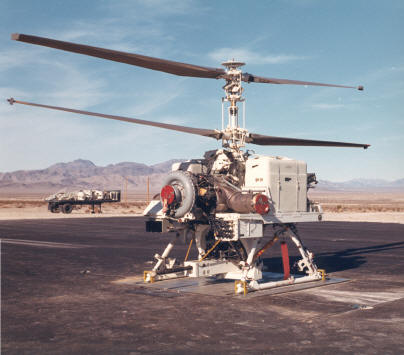 PANTHER at Nellis AFB and Indian Springs AFS, Nevada, by firing the guns,
grenade-drop and missiles on simulated targets using "Angel's Peak" at Las
Vegas A.F.S. as the long-range relay station.
PANTHER at Nellis AFB and Indian Springs AFS, Nevada, by firing the guns,
grenade-drop and missiles on simulated targets using "Angel's Peak" at Las
Vegas A.F.S. as the long-range relay station.
May 20, 1968 - Donald F. Hornig, Special Assistant to the President of the
United States for Science and Technology states to Dr. John Foster, Director,
OSD DDR&E, that QRC NITE PANTHER is a success in Vietnam. NITE GAZELLE R&D
effort accelerates.
August 1968 - a 4-vehicle, 1200-hr reliability test program is initiated.
Upon completion, a MTI-radar equipped QH-50D Test vehicle crashes at
Gyrodyne-New York plant facility. Investigation reveals the "purple-plague"; a
intermetallic formation effecting commercial-type transistors - this requires
the replacement with equivalent JAN-type transistors. Addition of
ARPA-created, 38-parameter OP-TEL telemetry system improves total system
reliability. ALL ARPA aircraft are
retrofitted. The U.S. Navy attempts to fund the repair of the
electronic subsystem (purple-plague) and other issues found in a Reliability Program
Report, but the Navy is unsuccessful.
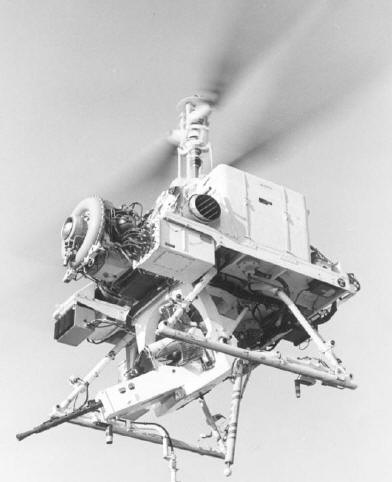 December 1, 1968 to March 31, 1969 - ARPA begins test flights of
QH-50D-Modified drones with long range fuel tanks at NATC-PAX RIVER to verify
flight envelope. Regular 4-Hour flight times are achieved.
December 1, 1968 to March 31, 1969 - ARPA begins test flights of
QH-50D-Modified drones with long range fuel tanks at NATC-PAX RIVER to verify
flight envelope. Regular 4-Hour flight times are achieved.
December 13, 1968 - Gyrodyne demonstrates the third variant of its "BIG U"
mount, built by Rockwell International. This mount bolts to the underside of
the QH-50 and allows the mounting of mini-guns to missiles to sensors. Later,
LARS missile tests score direct hits using Laser sensor on stationary tanks
with the QH-50D at 6200 Ft at Nellis Test Range, Nevada.
April
1969 - For the Period starting Feb. 1962 to April 1969, the Mean Time before
Loss (MTBL) rate for Atlantic Fleet is 250 Hrs, Pacific Fleet is 176 hrs and
Gyrodyne Development/Production is 235 Hrs.
Atlantic Fleet is 250 Hrs, Pacific Fleet is 176 hrs and
Gyrodyne Development/Production is 235 Hrs.
August 29, 1969 - Gyrodyne Manufactures its very
last helicopter (shown right); QH-50D, Bu.
No. DS-1758 after the U.S. Navy ends DASH procurement. While DS-1758 is
deployed to a NAVY tender, it doesn't stay there long and goes to AMARC for
storage. DS-1758 is later transferred to NAWC China Lake and is lost in 1990
during a maximum gross weight test carrying radar equipment during a weapons
test.
April 1969-1972 - The Advanced Research Project Agency (ARPA) begins
telemetry modification program of QH-50s citing the vehicle's "configuration
is well suited for ARPA-ASO needs" with Gyrodyne assistance, QH-50s fly urgent missions over Vietnam
involving real-time data acquisition to support intelligence, surveillance and
reconnaissance. Original objectives and modifications included the
installation of Day and Night TV with real-time data link, Airborne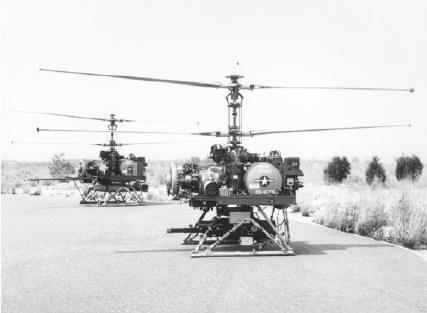 Moving
Target Indicator, MTI radar with real-time data link and a laser designator
and laser aided rocket. Later additions would include Bomblet dispenser, 40-mm
grenade launcher and Hypervelocity gun (50 cal w sabot and flechette rounds) (seen left).
Classified results (government only) are released in July 1975.
Moving
Target Indicator, MTI radar with real-time data link and a laser designator
and laser aided rocket. Later additions would include Bomblet dispenser, 40-mm
grenade launcher and Hypervelocity gun (50 cal w sabot and flechette rounds) (seen left).
Classified results (government only) are released in July 1975.
February
6, 1970 - Gyrodyne receives 'Walk-up Mode" contract to permit automatic
positioning of QH-50s armed with 7.62 mm Mini Gun and Iron Bombs, over target
for precise weapon/sensor delivery. Aircraft shown at
Right.
March 31, 1970 - the Japanese Maritime
Self-Defense Force (JMSDF) reports that of the 17 of the original 20
QH-50s that they started with (3 lost), 13,429 landings are made during 959.5
flight hours. Their MTBL is 419 hrs.
June 23, 1970 - While trying to increase vehicle lift capability for ARPA's
NITE GAZELLE/NITE PANTHER
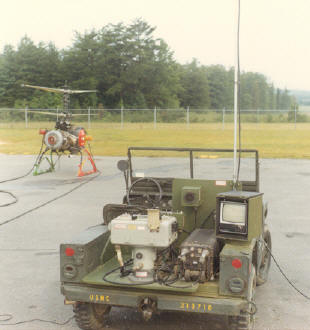 program, Gyrodyne's new 24' diameter rotor QH-50 is
lost due to design deficiencies (Rotor disks were too close). Gyrodyne
proposes a redesign 1 Oct. 1970.
program, Gyrodyne's new 24' diameter rotor QH-50 is
lost due to design deficiencies (Rotor disks were too close). Gyrodyne
proposes a redesign 1 Oct. 1970.
June 1970 - ARPA improvements to the basic command and control system result
in a change of MTBL of 80 Hr MTBL (all causes - shipboard to training rises to 226
hrs MTBL).
December 11, 1970 - QH-50 Standoff sensor
system, consisting of two BLOW-LOW QH-50Ds and two MTI-Radar equipped QH-50s
are transferred to the U.S. ARMY MICOM Target Management
Office (TMO). Aircraft provided are flown from
Jeep-mounted-Control
stations using the ARW-88 Radio System at White Sands Missile Range (WSMR) -
MARS Site, by Gyrodyne Drone Controllers John Howedel and John Nieman in
support of Air Defense Artillery (ADA).
This begins U.S. ARMY use of QH-50 system to
test other weapon systems by using QH-50 as a threat/target-simulator.
Gyrodyne operates the QH-50 system until 1974.
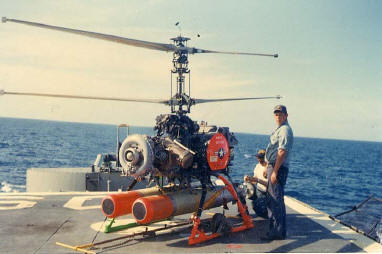 January 31, 1971 - The U.S. NAVY cancels the DASH Weapon System,
FLEET WIDE.
ALL QH-50s that survive DASH and SNOOPY are shipped to Davis-Monthan AMARC for storage.
ARPA missions continue. The ships that flew DASH are quickly sold to friendly nations via Foreign
Military Sales or scrapped. Gyrodyne begins layoffs of most company
personnel, world wide.
January 31, 1971 - The U.S. NAVY cancels the DASH Weapon System,
FLEET WIDE.
ALL QH-50s that survive DASH and SNOOPY are shipped to Davis-Monthan AMARC for storage.
ARPA missions continue. The ships that flew DASH are quickly sold to friendly nations via Foreign
Military Sales or scrapped. Gyrodyne begins layoffs of most company
personnel, world wide.
May 1971 - Seven Modified ARPA NITE
GAZELLE aircraft are offered to the United States ARMY Field Support Center /
Terrain Analysis Center but the transfer is refused; aircraft are directed to
ARMY Electronics Command (TACOM).
February 1972 - U.S. ARMY continues to acquire ARPA
assets - Eight NITE GAZELLE QH-50s, two Control Vans and two
maintenance vans are provided to ARMY Electronics Command (TACOM) that are
provided to TMO.
June 1972 - ARPA officially ends programs NITE GAZELLE/NITE PANTHER. By that time,
battlefield demonstration of the Nite Panther concept with real-time battlefield
TV surveillance with multiple interdiction weapon systems and demonstrated use
of extending operating range of using elevated relays (GRANDVIEW) is all
shown. At end of program, 12 NITE GAZELLE vehicles survived Vietnam. ALL NITE
GAZELLE assets officially transferred to U.S. ARMY Electronics Command (TACOM) on
February 1972.
November 30, 1972 - American troop withdrawal
from Vietnam is completed. The war that saw the QH-50 ASW Drone converted into
a surveillance and multi-mission program carrying all types of munitions and
weapons is in the end-phase as 16,000 Army advisors still remain in-country.
March 29, 1973 - The last
remaining American troops including 591 POWs from Hanoi, withdraw from Vietnam
ending America's longest war; Of the 2 million Americans who served in
Vietnam, 47,244 were killed in action (8000 of which are aircrews), 10,446
were killed in non-combat deaths, 153,329 are seriously wounded including
10,000 amputees and 2400 Americans are listed Missing in Action. For ALL
QH-50 Programs, operating on 165 U.S. Naval Ships to ARPA
Vietnam-Operations, over 50 QH-50s are shot down over Vietnam and 350 are lost
Fleet-wide during the entire Vietnam War with an estimated 5,000 Americans
serving, NONE are listed Killed from any cause, injured or listed Missing
in Action.
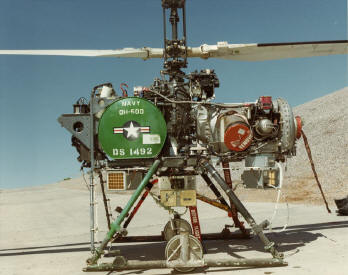 1970 to 1999 - Gyrodyne provides spares and technical assistance to
Naval Air Weapons Center (NAWC)
China Lake /Point Magu and U.S. ARMY Missile Command (MICOM) as QH-50s are beginning to be used as targets
& target emulators.
1970 to 1999 - Gyrodyne provides spares and technical assistance to
Naval Air Weapons Center (NAWC)
China Lake /Point Magu and U.S. ARMY Missile Command (MICOM) as QH-50s are beginning to be used as targets
& target emulators.
1974 to 1977 - US ARMY MICOM contracts for Flight Services; they consolidate
flight support for Beech's MQM-61A and the QH-50 into one package and formally
submit it for offers. Beechcraft / Raytheon is successful and begins operating both
systems at WSMR in late 1975. Brunswick wins small service contract to
inventory ALL QH-50 assets at MARS and Bldg 24012, aka "The Bat Cave" where
QH-50 ops would occur for the next 30+ years.
July 1975 - By this time, 100 QH-50Cs and 200 QH-50Ds are in storage at
Davis-Monthan Aircraft Maintenance And Regeneration Center (AMARC) under
control of Naval Air Systems Command (NASC/Code 5104A). In 10 years, all
aircraft will have been removed for either NAVY (China Lake NATC) or ARMY
(White Sands Missile Range, NM) use in weapons testing and threat simulation.
July 1975 - ARPA issues its Executive Summary of NITE GAZELLE and NITE PANTHER
Armed QH-50 missions stating, "The Modified QH-50D helicopter proved to be a
suitable platform for real-time remote surveillance operations over enemy
territory and when armed with various armament systems, it was demonstrated to
be suitable in a hunter / killer role."
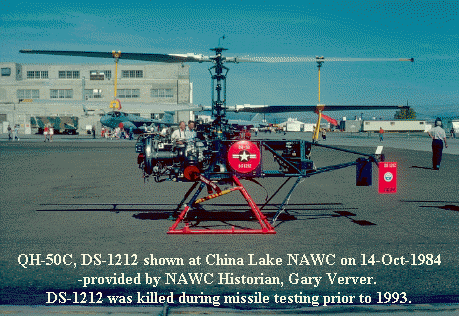
August 20, 1976 - The Naval Air Weapons Center
(NAWC) at China Lake, California re-activates the DASH Weapon System for Navy
Range-use since the CNO Struck the system from Ship-board use on January 31,
1971. Captain W.B. Haff, NWC Technical Officer oversees the first flight with
Harlan Reep acting as Drone Controller and Joe Chesney as Airframe Technical
Support.
February 14, 1977 - The Naval Air Weapons Center (NAWC) at China Lake,
California receives 54 QH-50C drones to use as missile / gunnery targets and creates
modifications to the RE-542 relay to integrate a second flight termination
system.
1977 - The Japanese Maritime Self-Defense Force
(JMSDF), facing the possibility of continuing their DASH program without the
United States keeping their program, cancels their DASH program and begins to
remove QH-50's from their four TAKATSUKI-class and three MINEGUMO-class
destroyers.
June 16, 1978 - The Naval Air Weapons Center
(NAWC) at China Lake, California begins experimenting with the HYBRID TERMINAL
ASSIST LANDING (HYTAL) System allowing for Autonomous Takeoff and Landings of
the modified QH-50 system. Al Sorenson and Joe Kitchens are photographed
preflighting the modified QH-50 HYTAL Drone. Lt Cdr. Robert S. Paskulovich,
USN, writes his Master's thesis of how the system works while attending Wayne
State University. He publishes the full results in June 1987 while attending
the Naval Post Graduate School.
1978 - 1980 US ARMY MICOM TMO contracts for
Flight Services; Brunswick wins the Flight-services contract for the 1st time.
Flight history for this period is missing; photographic history exists.
1980 - 1982 US ARMY MICOM TMO contracts for
Flight Services; Peter W. Dahl, Co., Inc wins the contract to provide Flight
Services from Oct. 1980 to Sept. 1982; they fly a mix of QH-50s and MQM-61As.
Drone Controller G. Gattis hires on; he will act as controller of the QH-50
for the next 25 years. DAHL flies 30 QH-50 flights of the total 50 flights
provided during this period.
1982 - 1984 US ARMY MICOM Target Management Office
(TMO) issued Contract DAAH01-83-C-0020 which Beechcraft/Raytheon wins to
provide Flight Services using army-owned QH-50s at White Sands Missile Range
(WSMR). From 11/82 to 10/83, 48 flights are conducted; 8 QH-50s are shot down
as targets and 2 crash during testing.
1984 US ARMY MICOM Target Management Office
(TMO) issues Contract DAAH01-84-C-A025 and Beechcraft/Raytheon wins the
contract to
provide Flight Services using army-owned QH-50s at White Sands Missile Range
(WSMR). From 3/84 to 10/84, 37 flights are conducted; 10 QH-50s are shot down
as targets.
1985 to 1988 - US ARMY MICOM Target Management
Office (TMO) issues Contract DAAH01-85-C-0004 and Beechcraft/Raytheon Flight
Services wins the contract back; from 12/84 to 7/88, 219 flights are conducted -
testing Sgt. York to Stinger Missiles, 29 QH-50s are shot down as targets and
6 are lost due to airframe malfunctions. During this period, the Beechcraft
personnel start converting the DASH training-aid transmissions into full-up
Aircraft which are then used in additional testing.
March 29, 1985 - Now having acquired 80 QH-50s from Davis-Monthan AMARC
for use as Missile Targets, the Aerial Targets Division of the Naval Warfare
Center at China Lake, Code 613 only has 35 QH-50s remaining. Code 613 flew
their targeting missions from the G-1 Range at China Lake NAWC. Code 613 also
uses a modified RV to fly QH-50s from anywhere in the United States.
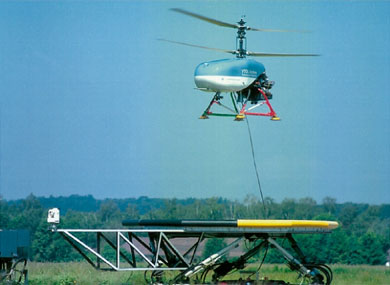 1986 to 2002 - Gyrodyne continues its licensed-affiliation with
Dornier GmbH of Friedrichshafen, Germany. Three QH-50D’s were provided so that Dornier,
working under a contract award by the German Office of Defense Technology
and
Procurement (BWB), could
employ state-of-the-art hydraulic actuators, an Allison 250-C20S turbine
engine and an autonomous digital
autopilot to flight test under the name of SEAMOS
(Sea Reconnaissance and Location System).
1986 to 2002 - Gyrodyne continues its licensed-affiliation with
Dornier GmbH of Friedrichshafen, Germany. Three QH-50D’s were provided so that Dornier,
working under a contract award by the German Office of Defense Technology
and
Procurement (BWB), could
employ state-of-the-art hydraulic actuators, an Allison 250-C20S turbine
engine and an autonomous digital
autopilot to flight test under the name of SEAMOS
(Sea Reconnaissance and Location System).
To see that flight film
Click Here.
The SEAMOS coaxial helicopter demonstrated its possible use for the German Navy’s new
K130 Corvette Class ships with its capability of landing on a rolling,
pitching ship deck completely autonomously in 1996. The primary tasks of
the SEAMOS
are comprehensive reconnaissance and target acquisition. It is planned to
enter service in the year 2005. Radar sensors, electro-optical sensors, and
a data link are planned as payload. Program is cancelled after Dornier
merges into EADS and EADS enters into agreement to sell Northrop-Grumman
VTOL-UAV
system, which never occurs. Mission Video can be seen by
clicking here.

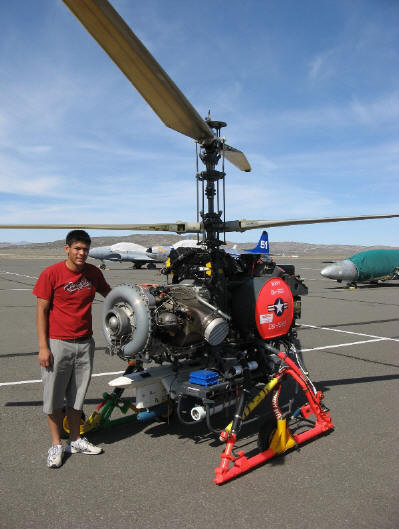
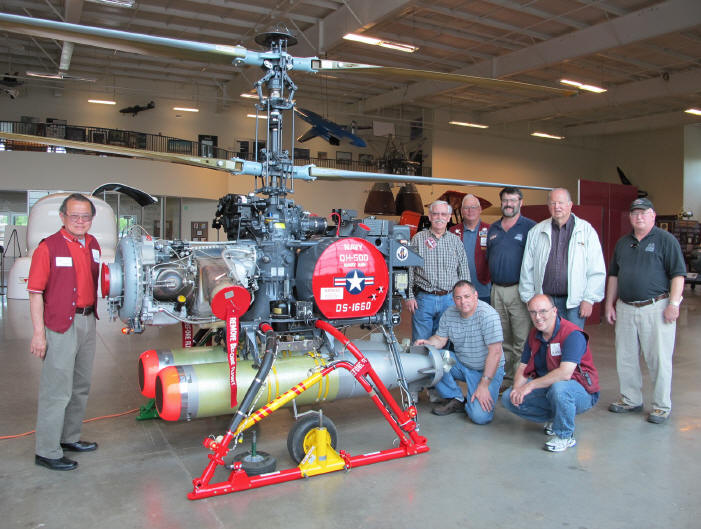
![]()
![]()
